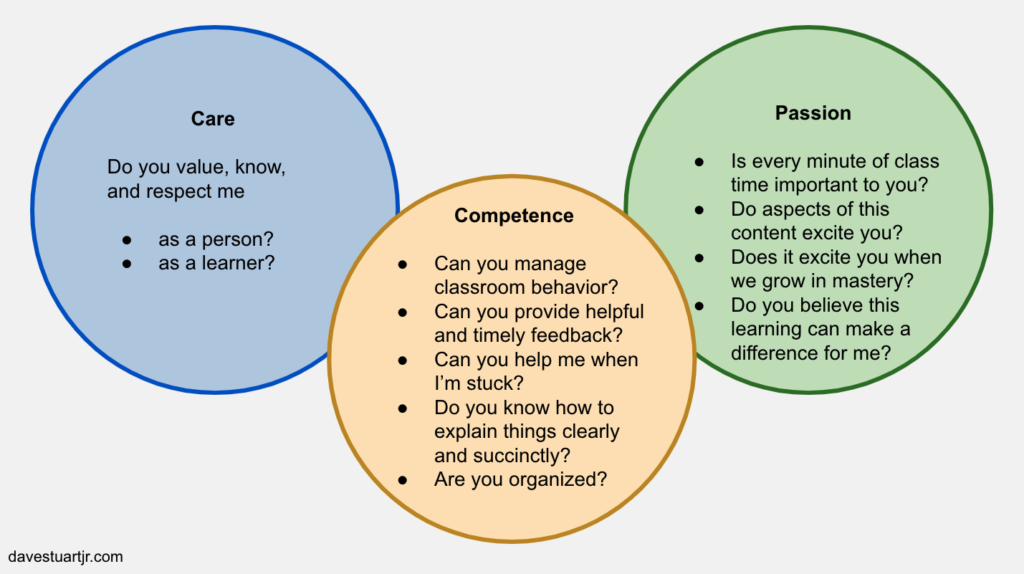Over the past few weeks, I've been sharing quick, common sense ways to impact teacher credibility as a classroom teacher. The master list of tactics (with updated links out to the most recent articles) is here. Through it all, we've been saying that Credibility is influenced by CCP: the signals we send of Care, Competence, and Passion.

Today, let's look at a simple way to boost your Competence. Do you pass “the first test of the class period?” (That's a riff on my last post re: Jocko Willink and alarm clocks.)
“What do we do when we enter this classroom?”
This is the question that our students first test us with, each and every time they come into the classroom. The testing isn't them being mean — it's them being a group of human beings. When groups come together, there's either a clear and normal way of doing things or there's not.
When the answers to the question are “I dunno” or “Wait for Mr. Stuart to start things” or “Chat with my buds,” we're probably not passing the test at all because we've not made a start of class procedure consistently clear. This'll end up leading to hundreds of wasted class minutes over the course of the school year, and it'll also slowly but surely degrade our sanity — kind of serious things.
When the students' answers to the question are something like “We're supposed to have a seat and independently begin the warm-up by the bell, but most of us don't do that and Stuart doesn't seem to know what to do about it,” then we're a lot closer to passing the test. In this case, we've done the teacher thing of making clear how class starts. We've communicated our sense of ownership and duty to this sacred time and space.
Step 1: Have and teach a clear plan for starting class.
Let's look at some examples of start of class procedures:
- How did Fred Rogers do it? He walked into the house while singing a song, switching out his outside jacket and shoes for an inside sweater and pair of tennis shoes. You might think it's a silly example. But, hum the tune of “It's a Beautiful Day in the Neighborhood” amongst a group of strangers and the smiles of recognition will begin to show you Rogers' genius. (I recently wrote an article on Fred's credibility tactics here.)
- How does our colleague and classroom management guru Lynsay Fabio do it? As you'd expect if you've seen Lynsay teach, it's 99th-percentile clear and directed. Students greet her at the door (pre-Covid, this involved a handshake), walk directly to their desks, calmly converse with anyone near them, situate their belongings, and begin on the warm-up. (I'll share a video of her explaining this in a minute.)
- How does your colleague DSJR do it? I'm a bit more laid back — often to a fault — but I am insistent on the following:
- You're always kind to one another.
- No wildness.
- By the time the bell has wrung, you're in your seat and have quietly started on your warm-up, which is always posted on the screen in front of you.
- The warm-up activity is almost always one of a few things:
- A brief reading with a writing prompt
- A set of “short answer question” writing prompts that review yesterday's learnings
- A practice set of assessment questions
- A brief writing prompt without a reading
- As students are doing this, I've got a timer running on the board of how long we have remaining for the warm-up, and I'm either taking attendance or MGCing a student or circulating in the room and ensuring students are making progress on the warm-up.
Step 2: Teach and model the plan with great specificity.
Lynsay does a good job modeling what this looks like in her class.
Step 3: Reinforce the plan, especially early on.
This is beyond the scope of a single article, but here are some Michael Linsin articles that have helped me:
- How To Begin Each Day On The Right Classroom Management Foot
- When To Enforce A Consequence And When To Redo A Routine
- How To Handle Sloppy Routines As The School Year Winds Down
- Why You Should Let Poorly Followed Routines Play Out
- How To Use Music To Make Routines More Fun And Effective
- What To Do When You Realize You’ve Lost Control Of Your Class
- How To Give A Reminder That Improves Behavior
(I could keep listing his articles. I just love that guy's heart for creating warm, stable classroom environments.)
Best to you, colleague,
DSJR
Chris Vander Ark says
So writing for a friend here. I love the ideas of students starting in such a focused way each time they enter. This feels more suited to 9th graders than seniors–especially, say, a group that has gone through the pandemic and seem still not ready for normal school, who come most days and are often on their phones, and for whom homework–ok, classwork too–seems optional–I often feel that I could sell anything, but this has me pondering. Still–the ideas here are spot on for me right now, I know.